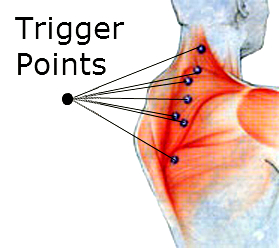Have you ever wondered why your pain never goes away?

Ever have aching pain in your muscles that seems to never go away? You tried taking pain medications, but realize you are only getting temporary relief. Maybe you’ve been adjusted by a chiropractor or seen a physical therapist and yet the pain keeps coming back! You might have even had X-rays or MRIs, yet the source of your pain remains a mystery. You might have myofascial pain syndrome.
Did you know that myofascial pain could be the root cause of most chronic pain cases! Researched showed that among 283 consecutive admissions to a comprehensive pain center, 85 percent were assigned a primary organic diagnosis of myofascial syndrome (Fishbain et al., 1986). This diagnosis was made independently by a neurosurgeon and a physiatrist based on physical examination for soft tissue findings as described by Travell (Travell and Rinzler, 1952; Simons and Travell, 1983). Another study suggested that 31% of visits to internal medical group practices for acute pain were actually myofascial pain (Skootsky, 1986). So what exactly is myofascial pain syndrome?
Simply stated, myofascial pain syndrome is a chronic pain disorder. Pressing on sensitive spots within your muscles causes pain locally and or pain in areas that appear to be unrelated. Anatomically speaking, myofascial is a strong, dense, flexible, connective tissue that covers all the muscles and bones of our body. It aids in support of our musculoskeletal system. Underneath this fascia covering, trigger points can form. A trigger point is a localized contraction of muscle fibers in the muscle belly. To explain this further, if the whole muscle was to contract, we would call that a cramp or muscle spasm. When just a small portion of the muscle spasms, we call it a trigger point. They usually range from the size of a pea to a large marble and can be felt just underneath the skin, palpable in the muscle. When this small patch of localized muscle contracts, it cuts off its own blood supply and becomes toxic, full of lactic acid and metabolic waste, unable to release. Nerves located at the surface in and around the area become hypersensitive and create large amounts of noxious pain. When a collection of these trigger points form in a given area, we now call this myofascial pain syndrome. Cumulatively, this generates feelings of aches, burns and other strange sensations that generally make you feel a surprising amount of discomfort, irritation, and overall yuck.
You may be asking yourself why we get trigger points in the first place? The formation of trigger points can come from repetitive strains, poor posture, overloading a muscle, and injury. A lot of us have jobs where we perform repetitive motions daily, not to mention, while spending large amounts of time in a seated position.
Fortunately, treating myofascial pain syndrome can be quite effective if the doctor or therapist is knowledgeable and utilizes a hands on approach. All too often, patients will end up having trigger point injections done when a more simple and cost effective therapy could have been done. When in the right hands, the release of trigger points can be done with myofascial release and other soft tissue techniques. An example would be a combination of direct pressure, and moving a particular muscle through its full range of motion. This will cause the trigger point, that focal tight constricted muscle, to release and resume normal healthy function. This can be done several times in an area to help remove the trigger points and resolve myofascial pain syndrome. It can also be done at home once the patient has a understanding of the basics and what they are trying to accomplish. Typically a few sessions will resolve most myofascial pain syndromes. In cases where more work is needed, outside exacerbating factors may need to be addressed.
Like always, I hope this read has been a informative and entertaining. If you or someone else you know is suffering from what you suspect is myofascial pain syndrome, please refer them to us or someone else capable of helping them. And always, if you liked this article please share! Thank you.
-Dr. Colt Andrea D.C.
National Board Certified Chiropractor located in Jacksonville Fl.
Fishbain, A.A., Goldberg, M., Meagher, B.R., Steele, R., and Rosomoff, H. Male and female chronic pain patients categorized by DSM-III psychiatric diagnostic criteria. Pain 26:181-197, 1986. [PubMed]
Skootsky, S. Incidence of myofascial pain in an internal medical group practice. Paper presented to the American Pain Society, Washington, DC, November 6-9, 1986.
Travell, J.G., and Rinzler, S.H. The myofascial genesis of pain. Postgraduate Medicine 11:425-434, 1952. [PubMed]

Reblogged this on A Healthy Midwest.
LikeLike
Reblogged this on Dr. Levy Riley III.
LikeLike